“Solutions will not be found while Indigenous people are treated as victims for whom someone else must find solutions.”
– Malcolm Fraser, Australian politician
I grew up in the ’60s, during the “civil rights era” – not that it didn’t exist prior nor after, but it has come to be known by that moniker. And in the 70s and 80s in particular I was active in the gay civil rights movement. I say active in the sense that I participated in rallies, marches, letter writing campaigns, educational initiatives, and more. And then, as the wheel of time continued turning, and things like career and other personal stuff became more pressing, at least in my mind, active participation slipped away. Oh, I’ll go to a gay pride parade now and again, but generally only if it is convenient in the moment. And I’ll still write a letter here and there to a congressional representative, president or whomever – though even that I must admit is likely only because it’s been made so easy by online campaigns. And I contribute financially to a scattered few organizations that are active.
But, I’ve been at arms’ length from it all, no question, and particularly if we look outside of those issues that have direct bearing on my life or that of close friends or family. So it’s been interesting to have that whole world creep slowly back into mine while living with Henry, as he’s become more and more active in the first people’s or indigenous people’s rights movement. And the impact isn’t just at a distance anymore, because he’s been so involved, that world has entered our home in one guise or another. The current big issue has been that of the Qom, or Toba (respectively their names in their own language or that of the neighboring Guarani, the latter more widely adopted in the Spanish speaking world – the former meaning “the people” and the latter meaning “the opposite”, supposedly given that they were the opposing and living on the other side of the river tribe).
This is an issue that would take far more than a brief summary to explore, but I’m going to give an attempt to state it in a nutshell. The Qom are an indigenous group of approximately 50,000 people living between Argentina, Paraguay and Bolivia, the bulk of them in northern Argentina in the provinces of Formosa and Chaco. If we go back in history, one of the earliest recorded notes about them that I’ve found shows up in a 1913 report listed in the Catholic Encyclopedia which is a fairly harsh assessment of the tribe, and clearly comes from the viewpoint of the conquistador culture.
But let’s jump to that nutshell. Back in 1940 the Argentine government returned to the tribe a 2,042 hectare (5,045 acre) area of land to be theirs in perpetuity. The Qom have always been a marginalized people, as many if not most indigenous peoples are here. And over the last decade or so in particular, the relationship between them and the government has eroded – public hospitals in the region have been simply shut down (there’s a group of volunteer physicians that now go up there on the weekends to provide medical care as much as they can), schools, particularly past elementary level have been cut, the processing of national documents, the national identity card in particular, have been virtually suspended, leaving the people without official status, and then, in 2007, the Argentine government expropriated some 600 hectares, or roughly 30% of the tribal lands, to build an agricultural study institute for the university system, displacing numerous families, and also cutting off access to one of the few fresh water supplies in the area.
And that jumps us into the last year or so in which the tribe gave up on negotiating for the return of their lands and started active protests. First, they blocked off the local highway, preventing access to the facility. For awhile the government apparently, more or less, tolerated this, but in the middle of last year things came to a head when a group of federal police officers shot and killed two of the protesters, one of whom was a tribal police officer. Violent raids that have included beatings, setting fire to homes, and death threats have increased against the people, much of it perpetrated by the federal police, and the regional and national governments have basically shutdown any dialog with tribal leaders. So, in mid-December, a group of Qom headed down to Buenos Aires, where they have setup a small tent village at the intersection of Avenidas de Mayo and 9 de Julio. And Henry and many of the other folk at the university have gotten actively involved in supporting them – both in helping them organize and in some basic services – Henry has spent many an evening cooking a meal for the group out there on the streets (some news media have reported the protest as a hunger strike, which it’s not).
And that’s where it has come into our home, as he has offered up space for them to come and get off the street now and again – maybe a dozen of those who are there 24/7 – it gives them a place to, in turn, take a shower, clean their clothes, get a hot meal (I’m afraid the fare that we tend to have in house is a bit outside their norm, as one of them pointed out while downing some wickedly spicy Banjari (India) vegetarian food that he’d never had a dinner that didn’t consist of a milanesa with potatoes, in his life), and a comfortable night’s sleep. Many a night we have anywhere from 2-4 of them on mattresses on the floor. And, two months or so into the protest, a major march organized on the Congress took place last week with the support of both the university group as well as others enlisted to help swell the ranks – I’d guess there were, by the time the march reached the plaza, around 500 people. I’ll leave most of the rest in pictures….
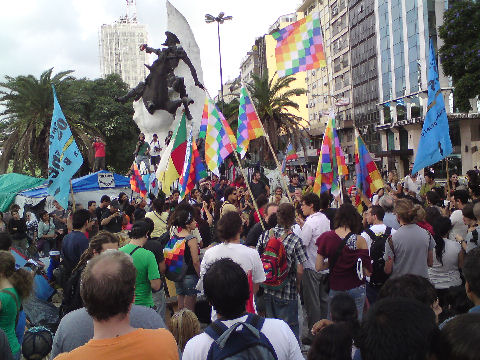
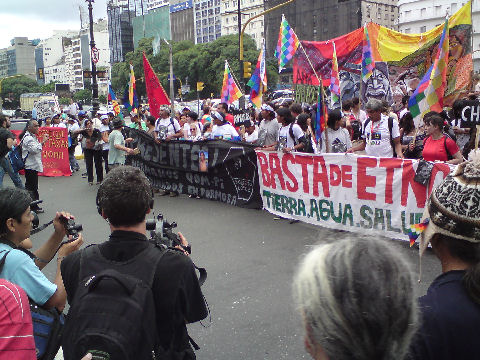
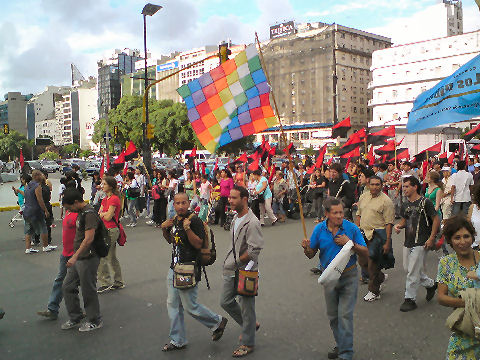
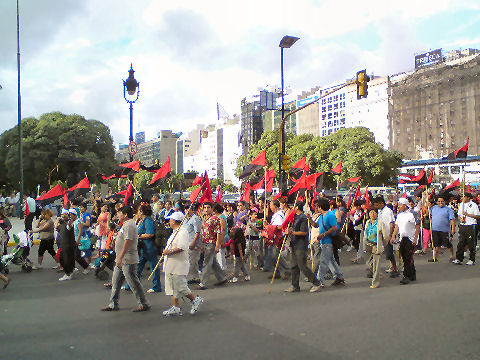
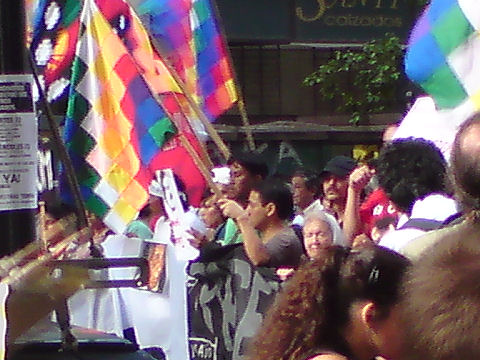
(There’s Henry in the middle in the grey-brown t-shirt, waving a flag.)
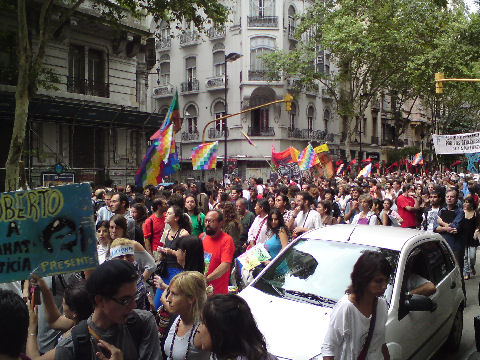
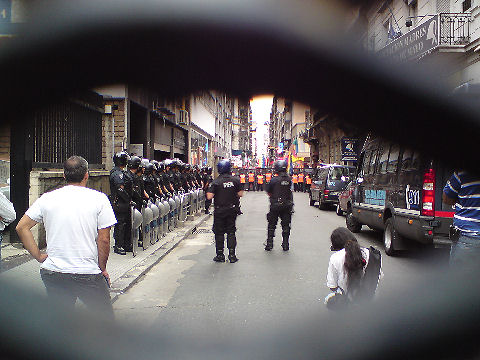
As the march approached the Congreso plaza, they took a side detour by a block, only to find themselves blocked (I think they knew they were going to be) by a rather overkill number of federal police officers in riot gear. It took me a little to find out why this one block was cordoned off, it turns out it is the block with the Casa de Formosa on it, an administration and tourism center for the government of the region where this is all centered. Not that anyone in the march was being or even suggesting violence – mostly they were singing folk songs and chanting for the return of their lands and water, the cessation of violence by the PFA, education, healthcare, and full status as citizens. They sang some songs to the police and then went up and around and continued into the plaza.
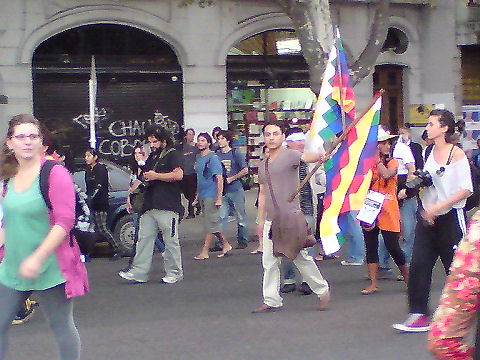
And, Henry again with his flag. Hey, gotta get something personal in here, right?
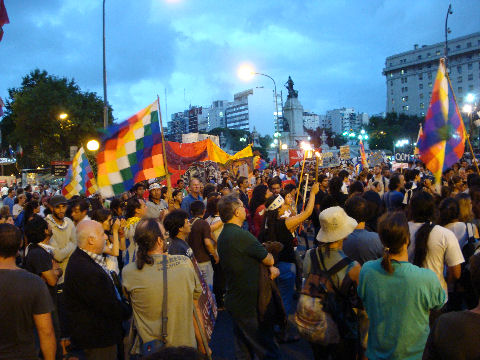
Singing about the Pachamama, or Mother Earth – sorry the video cut off early, the camera just stopped suddenly.